Learn more about Urbanism Next:
[embeddoc url=”https://urbanismnext.uoregon.edu/files/2017/06/Urbanism-Next-Framework_080618-t65jcs.pdf” download=”all” viewer=”google” ]
While the Urbanism Next blog presents a compilation of research and articles from a variety of sources, we are also conducting our own research. This page includes a series of papers on issues related to Urbanism Next. The intention is to introduce you to some key topics that will be affecting how cities develop as they face ongoing and transformative changes in technology.
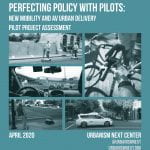 Perfecting Policy with Pilots: New Mobility and AV Delivery Pilot Project Assessment is an assessment of 220 pilot projects from around the country.
Perfecting Policy with Pilots: New Mobility and AV Delivery Pilot Project Assessment is an assessment of 220 pilot projects from around the country.
Urbanism Next Framework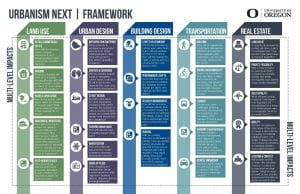 (Urbanism Next) One of the key challenges cities face is understanding the range of areas that are being affected or will be affected by emerging technologies, and how these areas are related. The Urbanism Next Framework organizes impacts based on five key areas— land use, urban design, building design, transportation, and real estate—and relates those to the implications they have on equity, health and safety, the environment, and the economy. It then considers what we should do to ensure that emerging technologies help communities achieve their goals.
(Urbanism Next) One of the key challenges cities face is understanding the range of areas that are being affected or will be affected by emerging technologies, and how these areas are related. The Urbanism Next Framework organizes impacts based on five key areas— land use, urban design, building design, transportation, and real estate—and relates those to the implications they have on equity, health and safety, the environment, and the economy. It then considers what we should do to ensure that emerging technologies help communities achieve their goals.
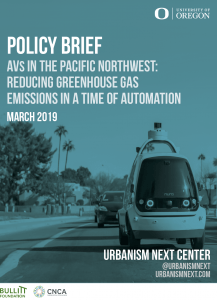 Policy Brief: AVs in the Pacific Northwest: Reducing Greenhouse Gas Emissions in a Time of Automation (Howell, Larco, Lewis, and Steckler) summarizes the key takeaways from New Mobility in the Right-of-Way and AVs in the Pacific Northwest. (Both reports are included below.) This policy brief outlines our main findings and includes a series of process/procedural and policy recommendations for cities to consider as they adopt new mobility plans and enable automated vehicles.
Policy Brief: AVs in the Pacific Northwest: Reducing Greenhouse Gas Emissions in a Time of Automation (Howell, Larco, Lewis, and Steckler) summarizes the key takeaways from New Mobility in the Right-of-Way and AVs in the Pacific Northwest. (Both reports are included below.) This policy brief outlines our main findings and includes a series of process/procedural and policy recommendations for cities to consider as they adopt new mobility plans and enable automated vehicles.
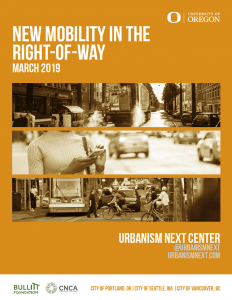 New Mobility in the Right-of-Way (Howell, Larco, Lewis, and Steckler) explores the ways in which demand for the right-of-way, broadly, but the curb, more specifically, is changing. The curb has long been in high demand with multiple users vying for limited space, especially for the purposes of parking personal vehicles. However, TNCs and other services have helped to usher in a new age that involves an increased demand for short-term loading and micromobility device parking. AVs will likely exacerbate existing issues with the right-of-way and the curb, which is why it is important that cities tackle curb management in new ways. This report categorizes and summarizes efforts that are already underway in cities across the world to rethink curb management and identifies major research gaps. New Mobility in the Right-of-Way summarizes the second phase of research from a project involving the Carbon Neutral Cities Alliance at the Urban Sustainability Directors Network (CNCA/USDN) and the cities of Portland, OR; Seattle, WA; and Vancouver, BC, and was generously supported by the Bullitt Foundation.
New Mobility in the Right-of-Way (Howell, Larco, Lewis, and Steckler) explores the ways in which demand for the right-of-way, broadly, but the curb, more specifically, is changing. The curb has long been in high demand with multiple users vying for limited space, especially for the purposes of parking personal vehicles. However, TNCs and other services have helped to usher in a new age that involves an increased demand for short-term loading and micromobility device parking. AVs will likely exacerbate existing issues with the right-of-way and the curb, which is why it is important that cities tackle curb management in new ways. This report categorizes and summarizes efforts that are already underway in cities across the world to rethink curb management and identifies major research gaps. New Mobility in the Right-of-Way summarizes the second phase of research from a project involving the Carbon Neutral Cities Alliance at the Urban Sustainability Directors Network (CNCA/USDN) and the cities of Portland, OR; Seattle, WA; and Vancouver, BC, and was generously supported by the Bullitt Foundation.
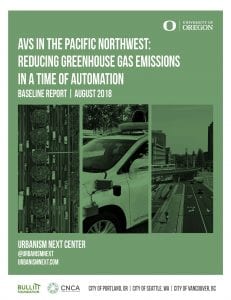 AVs in the Pacific Northwest: Reducing Greenhouse Gas Emissions in a Time of Automation (Larco, Howell, Lewis, and Steckler). The policy decisions made over the next 10 years that shape the deployment of autonomous vehicles (AVs) will have significant repercussions for our communities as well as environmental repercussions related to greenhouse gas emissions and adaptation to climate change. In recognition of that, Urbanism Next worked with the cities of Portland, Seattle, and Vancouver, BC to better understand how new mobility technologies such as AVs could affect greenhouse gas emissions thereby impacting their ability to achieve the goals in their respective climate action plans. This project grew out of a partnership between the Carbon Neutral Cities Alliance at the Urban Sustainability Directors Network (CNCA/USDN) and the Cities of Portland, Seattle, and Vancouver and was generously supported by the Bullitt Foundation.
AVs in the Pacific Northwest: Reducing Greenhouse Gas Emissions in a Time of Automation (Larco, Howell, Lewis, and Steckler). The policy decisions made over the next 10 years that shape the deployment of autonomous vehicles (AVs) will have significant repercussions for our communities as well as environmental repercussions related to greenhouse gas emissions and adaptation to climate change. In recognition of that, Urbanism Next worked with the cities of Portland, Seattle, and Vancouver, BC to better understand how new mobility technologies such as AVs could affect greenhouse gas emissions thereby impacting their ability to achieve the goals in their respective climate action plans. This project grew out of a partnership between the Carbon Neutral Cities Alliance at the Urban Sustainability Directors Network (CNCA/USDN) and the Cities of Portland, Seattle, and Vancouver and was generously supported by the Bullitt Foundation.
Rethinking Streets in an Era of Driverless Cars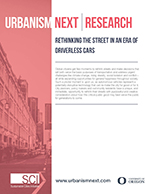 (Schlossberg, Riggs, Millard-Ball and Shay) presents ideas about how city planners, policy makers and community residents can address the introduction of autonomous vehicles. This white paper frames the introduction of AVs as an opportunity to rethink streets with purposeful and creative consideration about how this critical public good may best serve the public for generations to come.
(Schlossberg, Riggs, Millard-Ball and Shay) presents ideas about how city planners, policy makers and community residents can address the introduction of autonomous vehicles. This white paper frames the introduction of AVs as an opportunity to rethink streets with purposeful and creative consideration about how this critical public good may best serve the public for generations to come.
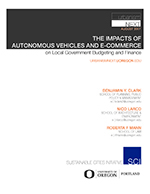 The Impact of AVs and E-Commerce on Local Government Budgeting and Finance (Clark, Larco and Mann) is a new report from us here at Urbanism Next/SCI that takes you through a city’s budget —both revenues and expenditures — and describes the areas that will be affected as AVs become commonplace and e-commerce takes on an even larger role in retail. City leaders have to start planning for this future now if they want to have a voice in what AVs/e-commerce will do to their cities.
The Impact of AVs and E-Commerce on Local Government Budgeting and Finance (Clark, Larco and Mann) is a new report from us here at Urbanism Next/SCI that takes you through a city’s budget —both revenues and expenditures — and describes the areas that will be affected as AVs become commonplace and e-commerce takes on an even larger role in retail. City leaders have to start planning for this future now if they want to have a voice in what AVs/e-commerce will do to their cities.
 Re-Imagining Retail (Carlson and Larco) builds on earlier posts about the challenges retail is currently facing, we look at the transformation retail is currently going through and the shift from brick-and-mortar, to e-commerce, to omnichannel approaches. The paper describes trends and includes data and resources that can help you understand where we are at, where we are heading, and where you can learn more.
Re-Imagining Retail (Carlson and Larco) builds on earlier posts about the challenges retail is currently facing, we look at the transformation retail is currently going through and the shift from brick-and-mortar, to e-commerce, to omnichannel approaches. The paper describes trends and includes data and resources that can help you understand where we are at, where we are heading, and where you can learn more.
 Warehousing (Carlson and Larco) looks at the changing nature of distribution networks with the rise of E-Commerce and the effects this will have on the size, number and distribution of Warehouses in cities.
Warehousing (Carlson and Larco) looks at the changing nature of distribution networks with the rise of E-Commerce and the effects this will have on the size, number and distribution of Warehouses in cities.
While we have been compiling research and articles on this blog for the last few months, we have also been working on our own research. Today marks the start of our publishing a series of brief papers on issues related to Urbanism Next. The intention is to introduce you to some key topics that will be affecting how cities develop as they face ongoing and transformative changes in technology.
The first paper is co-written by Galen Carlson and Nico Larco and is focused on Re-Imagining Retail. Building on earlier posts about the challenges retail is currently facing, we look at the transformation retail is currently going through and the shift from brick-and-mortar, to e-commerce, to omnichannel approaches. The paper describes trends and includes data and resources that can help you understand where we are at, where we are heading, and where you can learn more.
Look for additional papers on residential preferences, warehousing, and the effects of urbanism next issues on municipal budgets – coming in the coming weeks.
Mall foreclosures continue to rise as retailers face more and more competition from E-commerce and a large rush away from enclosed malls. Many owners are letting their loans default instead of trying to restructure as they see no easy future in a shifting economy.
These declining/failing properties not only cause problems for tenants, but also for the surrounding properties. “If a mall closes or goes into decline, you’re going to see declining property values in the area,” commented Arthur C. Nelson, professor of Urban Planning and Real Estate Development at the University of Arizona. “The mall is a marker.”
One of the early casualties in the shift to E-commerce.
Mark your calendars for OAPA’s (Oregon American Planning Association) webinar on Automated Vehicles on Tuesday January 24th at 12-1 pm PST
More info on the webinar:
“Automated Vehicle (AV) technology promises to reshape the transportation system and the built environment in ways not seen since the introduction of the automobile over a century ago. By revolutionizing the nature of personal mobility and removing the need for passengers to be in the car at all times, AVs have the potential to dramatically impact roadway design and the built environment to yield urban spaces that are safer, more efficient, and attractive. However, unlike America’s first experience with the automobile, it is hoped that policy makers will recognize and take advantage of this opportunity to reshape our urban areas in ways that promote safe, sustainable, and people-centered environments. AV technology offers an opportunity to balance what have long been seen as conflicting goals of safer and more efficient transportation systems and urban environments founded upon the principles of sustainability and human-centered design. But the twin goals of efficiency and urbanity can be achieved only through proactive planning and investment by federal, state, regional and local transportation agencies.
This webinar will review the innovative work Florida Department of Transportation and Florida State University are doing to take the first steps toward envisioning the future in an AV world, a future that can yield attractive, people-friendly, efficient and safe urban environments. In addition, this webinar will identify near and medium-term infrastructure investments and policy decisions that could enable a smooth transition to a transportation system dominated by AVs. Few understood and foresaw the massive impact the automobile would have upon travel behaviors, transportation systems, and the built environment over a century ago. This session hopes to prepare and equip local governments with the tools necessary to take advantage of this remarkable opportunity to reshape the built environment into more livable communities.”
As we continue to trend towards e-commerce and a range of delivery methods for products, warehouses – one of the key infrastructure elements of delivery – are going to both shift and proliferate. A report from Colliers looks at these shifts broadly, but pertinent to this blog, there are sections on First Mile and Last Mile of delivery that outline the changes we will be seeing in the built environment. Some takeaways:
A great graphic that shows the complexity of new shopping and delivery methods is below. Many forms of delivery and each has its own land use and transportation implications.
A recent article in the Wall Street Journal documents the continued rise of e-commerce coupled with the inevitable slide of brick-and-mortar stores. A few key numbers:
Probably the most striking number for the subject of this blog, brick-and-mortar shopping traffic (as in the number of times people went into stores) declined by 12%. That number – if it continues – will inevitably lead to a drop in the amount of brick-and-mortar stores and major shifts in land use and transportation demand. This will potentially also decrease the vitality and activity around commercial areas.
CityLab has posted a report from this years Consumer Electronics Show and – unsurprisingly – the roll-out of AV’s seems to be focused on shared fleets and they will focus on freight and high occupancy transport. Cost seems to be the largest factor early on with AV technology being cost-prohibitive for individual ownership (although Tesla might have something to say about that). Another reason is simply the ability to monitor and modify cars and algorithms – much easier to do roll-out and testing in limited contact points via larger shared fleets.
This is not to say that shared vehicles are the only future for AV’s – but thier initiation happening as shared vehicles is promising and gives a bit of time to figure out how best to promote and cement that future over individual ownership – probably the most critical issue in avoiding a dystopian future.

Right hooks are just one of many issues that people on bike confront when trying to navigate city streets imperfectly designed for bicycle transportation and it seems that this is one area that autonomous vehicles don’t yet have an answer for, according to this article from the Guardian. If driverless cars only had to deal with other cars, then behavior and safety could be much more regulated, and in fact the vast safety savings anticipated from autonomous vehicles comes from a reduction in vehicle to vehicle, or even solo vehicle, crashes. But, cities are also made up of people who walk, bike, and roll, presenting different challenges due to speed, mobility, and the fact that the goal of walking, biking, or rolling is not always to maximize speed. And these other modes often have their own infrastructure that varies by block and intersection and part of town. For cycling, infrastructure ranges from simple bike lanes to protected bike lanes to no dedicated infrastructure at all, adding to the complexity. Figuring out how driverless vehicles will complement biking, especially as a worldwide resurgence in this sustainable and space saving form of transportation is taking place, will be especially important to get right for the sustainability of our cities.
CityLab discusses a proposal to remove cars from streets by building tunnels for driverless cars.
When it comes down to it, transportation is all about the space. Want to maximize fast movement of vehicles unimpeded? Allocate plenty of space for cars and limit distractions like other modes or intersections or driveways. Want to keep driving easy and convenient? Allocate (actually, legislate) the provision of parking at home, at work, at shopping, and at play. Want to create protected bikeways that actually feel comfortable for people to use? Re-allocate street space for that purpose. Etc. Even for autonomous and connected vehicles, one of the arguments in their favor is their space saving qualities, from right-sizing the vehicles to the trip at hand to being able to reduce the space in between moving vehicles on the road.
Cities exist as a place where multiple activities come together in a relatively confined area. And space is a finite resource in cities; how that space is allocate will directly dictate what modes of transport are the most efficient, most convenient, most comfortable, and create the most enjoyable, livable environment in which to be a human being. This mapping project of the “Distribution of Public Space at Urban Intersections” nicely illustrates how urban transportation space tends to get distributed now. And the space-saving nature of bicycle transportation is an explicit guiding factor, in addition to environmental or health factors, for transportation planning in Copenhagen according to a recent municipal performance report.
How cities decide to right-size urban public space as more options for right-sizing transportation modes is perhaps the key question of the next decade.
Part of the promise of new technological opportunities within transportation is the opportunity to use space more efficiently. Connected and autonomous vehicles can travel closer together, ride-sharing can fill a portion of the staggering amount of empty vehicle seats on our streets and thus reduce some vehicles, and ride-hailing transportation may make it possible to reduce overall car ownership and the need for so much parking, freeing up space on streets and in our communities. Yet, one of the most efficient inventions humanity has ever created also happens to be a space-saving form of mobility – the bicycle. Cities of all shapes and sizes all over the world are “re-discovering” how space, efficiency, distance, economy, health, and sustainability can be addressed through investing in bicycle transportation. Along those lines, London just announced a massive investment in bicycle transportation, seeking to make it a rational option for both short and commute-distance trips. Our challenge now, is figuring out how to right-size each form of transportation, from walking to biking to carsharing to transit to AVs, throughout our cities and communities to maximize not only our ability to reach our desired destinations quickly, but also to maximize the efficient use of limited space, as well as addressing issues of equity, health, and the environment.
In an interview in the Verge, Secretary of Transportation Anthony Foxx envisions a future of cities with AVs, discussing the implications for regulations and safety. How will shifts in transportation affect the rest of society? How can AVs enhance communities and improve access in underserved communities? Are we prepared for AVs?
This is probably one of the fundamental questions to how the future of AVs will roll out. This article from Slate looks at three basic scenarios of AV ownership and use: Private ownership (what we have now), fleet ownership for private rides (think Uber/Lyft), and fleet ownership for shared rides (think Uber Pool).
While the article lays out convincing parameters for these scenarios, it doesn’t address the potential for differentiated models based on density. Cities may lean towards fleet ownership and/or shared rides, but as we move further and further out into the suburbs, fleet management will be more difficult to do efficiently and profitably. This seems like it would push towards more private ownership in these locations. If so, some of the parking related benefits of AVs – to name only one of many issues – may be uneven across urban areas.
This article looks at the very real possibility that AVs will actually move slower in central cities than cars do today. This is based on two notions – first, the idea that AV’s risk averse algorithms will understandably slow them down or stop them whenever a pedestrian or cyclist crosses the street. Second, the idea that pedestrians and cyclists – now sure that cars will be stopping – will step off the curb or into traffic whenever they please, creating havoc for the efficiency of automobiles. Author Adam Millard-Ball asks us to imagine AVs trying to get through Manhattan while obeying all traffic rules and stopping with every pedestrians crossing at will.
The article points to a key issue regarding AVs in dense environments and how the interaction with other modes will severely hamper some of the largely claimed increases in speed. It would seem that these increases will most probably exist in suburban and exurban areas, but not as much in central cores. How does the speedy highway leading into the city deal with the congestion glut as cars enter slower networks downtown?
In another positive story about transit and ridesourcing working together instead of in competition, Boston’s MBTA is using Bridj on-demand shuttle service for late-night trips. This is a strategy to compensate for recently limited late-night service. Not only will this fill a need, but also lets the agency gather data on use that can lead to more efficient future service.
A few positive developments for the future of transit today! As we have discussed before – the question of transit + ridesourcing (Uber/Lyft) as opposed to transit vs. ridesourcing will be one of the most fundamental questions to how cities develop in an AV future. If there is collaboration, accessibility can increase tremendously without (as much) increase in congestion or a push towards sprawl. If they are in competition – and ridesourcing triumphs in a way that makes transit unfeasible – we are in for the darkest of futures (see previous posts for more on this). So now – onto the news:
In Seattle, Uber is endorsing the cities $54 Billion (with a ‘B’) transit ballot initiative. Uber has not traditionally endorse ballot initiatives one way or another, but the fact they are supporting transit, coupled with the partnerships they are developing with cities to work cooperatively in the mobility world points to a promising future. Of interest in the article is also Uber’s Seattle General Manager’s quote that Uber’s mission is to “reduce congestion and pollution by moving more people with fewer cars, and provide better mobility options for all people living in the region.” Uber and transit combining to be mobility/accessibility companies, and not ridesource and transit individually, is a large step in the right direction.
In that same vein, this article talks about AV paratransit being developed in Hillsborough, Florida – launch expected in 2017. Could be a great option for hardest to serve and for first/last mile access to transit.
This article talks about how the combination of AV’s and E-Commerce will create havoc for the retail industry. More of our shopping will go online while bricks and mortar stores will start to act more like distribution warehouses as AV’s are sent to run errands and pick up things we need. This will have large implications for how retail works in urban areas – where it is located, how much of it we need built, and a shift (already occurring) from retail being based on a need to retail being proposed as an experience.
Large implications for activity centers throughout urbanized areas as many of them have retail as a core vitality generator.
This is a two part series from City Observatory that talks about the projected cost of autonomous vehicles and the effects this will have on their adoption (and their marketshare). The first article cityobservatory.org/how-much-will-autonomous-vehicles-cost/ has a collection of cost estimates from various sources. The second article http://cityobservatory.org/price-of-autonomous-cars/ looks at the effects of pricing on everything from AV’s effect on transit to the behavioral effects of our being more aware of the cost of trips (as we may no longer have that sunk cost of the automobile).
Advances in technology such as the advent of autonomous vehicles (AVs), the rise of E-commerce, and the proliferation of the sharing economy are having profound effects not only on how we live, move, and spend our time in cities, but also increasingly on urban form and development itself. The University of Oregon’s Urbanism Next Center focuses on the ramifications of these changes. Researchers are working with leaders from the public, private, and academic sectors across North America and Europe to better understand the secondary impacts of emerging technologies on cities and ensure that governments from the local to federal level have the information they need to make informed decisions that improve equity and health outcomes, as well as help achieve community goals related to the economy and the environment.
Urbanism Next is meant to be a source for those interested in technology and the built environment and is particularly targeted towards urban designers, architects, planners, landscape architects, and developers. The Urbanism Next Blog is part of the Sustainable Cities Initiative’s (SCI) Urbanism Next Research Center at the University of Oregon. Visit the blog for links to relevant articles, commentaries on emerging trends, and critical thinking around the future of our cities.
Learn more about Urbanism Next:
[embeddoc url=”https://urbanismnext.uoregon.edu/files/2017/06/Urbanism-Next-Framework_080618-t65jcs.pdf” download=”all” viewer=”google” ]